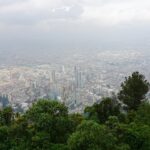Posts tagged with 'Bogota'
Imagine living in a country where everyone has access to clean, affordable public transportation to reach their jobs, schools and healthcare needs without relying on polluting fossil fuels. That vision isn’t too far from where India hopes to be by ...

The message is everywhere: You (alone) can save the planet. Choose a veggie burger instead of beef. Book this flight, not that one. Buy thrift over fast fashion. Shrink your “carbon footprint.” But here’s what most people don’t know: The ...

Transport is one of the fastest-growing sources of greenhouse gas emissions, accounting for 24% of carbon emissions worldwide. Nearly three-quarters of those emissions come from road vehicles. Solutions like electrification and increased public transport can reduce the transport sector’s emissions, but they ...

Public transit is not only a vital network connecting people to jobs, services and one another; it’s also an important climate solution. The world needs to double public transit capacity by 2030 as part of its larger roadmap to slash planet-warming emissions ...

2024 was tumultuous. Cities saw record-breaking temperatures, a sharp uptick in climate-related disasters, violent conflict in too many places, and contentious elections that shifted local, national and regional politics. But amidst the tumult, cities centered themselves as global leaders in ...

2024 has been a tumultuous year: More than half the world’s population went to the ballot box — some voting for radical change — extraordinary weather events have devastated communities and countries have been rocked by continued violent conflict. Given ...

Livability is key to the quality of city life as we look to the future. We don’t have to look far into that future to see how this plays out on the streets. On Sunday, December 15, 1974, a group ...

Moving around cities in a variety of ways is getting easier and more convenient: whether it’s improved public transportation systems, wider sidewalks or more dedicated bike lanes. With the rise of smartphone technology and GPS, shared mobility services — like ...

Bogotá, Colombia is in the throes of a water crisis. After several months of dry weather caused by El Niño, the Chingaza reservoir system, which provides 70% of Bogotá’s water, reached its lowest level in history. The city’s over 8 million residents are ...

Mexico became the first nation to declare access to safe mobility a human right in 2020 and two years later passed the General Law of Mobility and Road Safety to protect people, reduce collisions and promote sustainable modes of travel. Now, with this new ...

Over the past several months, the climate pattern El Niño has disrupted different regions and sectors across the world. Zimbabwe recently declared a state of disaster, due largely to El Niño-induced drought. The city government in Bogotá, Colombia, announced water rationing as reservoir levels ...

If a picture can tell a whole story, then the image below of an intersection in Dar es Salaam, Tanzania, shows the past, present and future of global transformation in the transport sector. During Transforming Transportation 2024, which focused on ...

In Bogotá, Colombia, over 3,000 people die prematurely each year due to exposure to air pollution—namely from PM2.5, a fine particulate matter produced by vehicle exhaust, burning and industrial outputs. Bogotá is not alone: According to 2021 data, of 174 ...

Public transport is one of the best, most cost-effective solutions available to address today’s climate and development challenges. Buses and trains can reduce greenhouse gas (GHG) emissions by up to two-thirds per passenger, per kilometer compared to private vehicles. The UN’s latest ...

Residents of Jakarta, Indonesia woke up on August 31, 2023, to a thick blanket of haze and news that their city was again ranked the most polluted in the world — one of many times during the last several months when air quality became ...

Page 1 of 11123...10...Last »

























